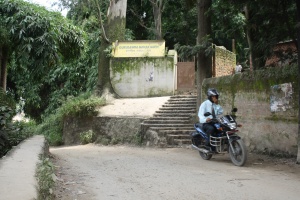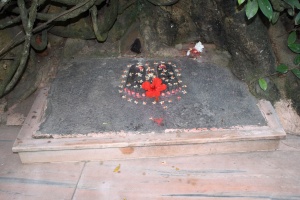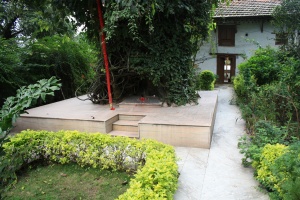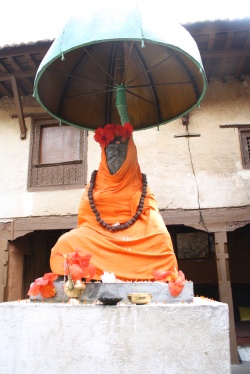Guru Nanak in Nepal
The Forgotten Shrine of the Sikhs Books on Kathmandu are silent about this shrine. It is not on the tourist map. No coaches park below the small forested hill by the river on the road to Balaju. The temple is left to bird song and the occasional visitor who either knows it is there or by chance comes upon the small weathered sign which says, “Guru Nanak Math” (27°43'31"N 85°18'19"E).
An arching stairway leads through trees and bamboo to the small building which from the outside looks like any Nepali farmhouse. I found the climb up the stairs refreshing even though I was a bit breathless. The city, which now encroaches on the fields about the hill, is so screened by greenery that one can almost forget its existence.
The busy sound of traffic trails further and further behind. Through openings in the trees can be seen the river and a high mountain. A small grassy clearing just before the house is just the kind of place a weary traveller would have welcomed. Cool. Quiet. Undisturbed.
The Search for the Shrine
The doorway to the lime-washed house is plastered with ochre earth. The black painted door is small in the way of old Nepal, so one stoops to enter. An old man, asleep on the clean, earthen floor sits up and smiles a welcome. His dog, curled up beside him, takes no notice. I beg his pardon. Perhaps I’ve made a mistake. I’m looking for the Guru Nanak Math.
He leads me barefooted across a freshly plastered courtyard at the centre of which is a shrine with a tulsi plant growing out of the top. It is difficult to make out the deities in the small niches but he agrees, as I think aloud, that they are Vishnu, Shiva and Parvati, Hanuman and Pashupatinath.
In a verandah are steep stairs which we climb to enter into a small dark room. At the centre, under a canopy, is an altar draped in red. Here, says my companion, reposes the Granth Sahib, written by Guru Nanak himself in letters of gold. I ask him to repeat what he said because if he is correct, then this almost forgotten shrine in a land not normally associated with the saint possesses a rare and unique relic.
The Priest shows me the shrine
Strangely, the priest who is Nepali, wears none of the symbols of Sikhism; turban, kara, kirpan or kanga. However, his greying hair is unshorn and, for a Nepali, he sports a fair beard. I learn, with undisguised excitement, that he belongs to the earliest unreformed order of Sikhs who are often unrecognisable from Vaishnavite Hindus. At Pashupatinath, I would have taken him for a sadhu.
He whisked me out of the courtyard into a small garden wild with shrubs and flowers. Under a large pipul tree he pointed out a stone slab on which were carved two feet, laid with roses. “The Guru’s,” he said. “It is at this spot that Guru Nanak sat in meditation. In that little shrine behind you, are buried the ashes of a Nepali king.”
We sat together on mossy steps leading up to the shrine, a strong scent of jasmine in the air as two bulbuls were pecking about the carved feet. And there he told me the story of the temple of the golden book and the shrine against which we sat.
History
It seems a Malla king of the early sixteenth century – the priest did not know his name – suffered a disturbed mind. His brothers, alarmed by his behaviour, banished him to India. Roaming forlornly through the holy city of Benaras he came upon the saint Guru Nanak and begged him to cure his affliction. After many visits and much beseeching, the guru advised the king to return to his kingdom where his health would be restored.
Miraculously, the saint preceded the king to Kathmandu for there he was, meditating under a pipal tree on a hill beside the river. The king visited him at once, begging the guru to return him to the palace. Guru Nanak refused to do so, saying that in this serene spot he had all he wanted. So the king had a temple built for his guru and a small shrine for himself where he often came to meditate. When the king died, some of his ashes were buried in the shrine according to his last wishes.
The considerable land has been encroached upon
A later king, Rana Bahadur Shah, also of unsound mind, is said to have found solace at the Guru Nanak Math. He gifted considerable land to the temple so it might never want for support.
Perhaps the records have long since perished because slowly the gurdwara lands have been encroached upon until only the hill remains. It would be tragedy if modern hungers consume the trees and push concrete within reach of the peaceful old building.
When I went back to sketch the garden and the temple, I was met by another old priest. I asked him if I might see the Guru’s footprints. “Ah yes,” he said, “they are the Guru Nanak’s feet, but they are also Vishnu’s. They are both the same.”
And who, I asked, wrote the golden book enshrined in the temple. “Sri Chand, the guru’s son,” he said. Was it not Guru Nanak?
By then the guru had gone to Tibet, he said. “But it is all the same. Our gods are our gods.”
Obviously the lovely, lonely Guru Nanak Math is in need of a Sikh Scholar to unravel its truths and legends. Until then it will remain a half-forgotten temple on a wooded hill threatened by the brick and concrete advances of Kathmandu.
Quotes
Entry for Gurdwara Nanak Math
from www.sikhnet.com
Shri Guru Nanak Dev ji's Visit to Nepal. At Kathmandu, the Guru Ji stayed near the Pashupatinath temple on the bank of Baghmati Ganga. He asked Bhai Mardana to play upon the rebec and himself sang one of his hymns. The yogis and ascetics of other cults gathered around the Guru and held discussions. The Guru forbade them from idol worship and made them devotees of the Lord. The king of Nepal, Raja Sasodhia Rajput Mahan Ranbir Singh came to the Guru Ji and received secular as well as religious instructions. It is said that with the blessing of the Guru the King had two sons. There are now two Dharamsalas in the memory of the Visit of Guru Nanak Dev ji, one managed by Nirmalas and other by Udasis. The Gurdwara is situated on the hillock on the western bank of the River Bashnumati.(27°43'31"N 85°18'19"E)
Entry for Sikh Temple, Kathmandu, Nepal
from allaboutsikhs.com
The gurudwara was founded in 1976 by the Sikh sangat of Kathmandu. There are in all five historical Gurudwaras here. The most famous being "Nanak Math" situated on the bank of river Bishnumati. It is said that Guru Nanak Sahib actually stayed here for sometime and mediated at this serene sight. Community services include Sangat Langer on Saturday afternoons. There are about 400 members of the sikh community in the area. Address: Kupandole, Kathmandu, (Nepal)
Founder of a World Religion
by Sirdar Kapur Singh at www.sikhcoalition.org
The third Central teaching of Guru Nanak is that the fully integrated person, the liberated individual, the deified man, must revert to the world and society to participate in its activities to guide and assist it in striving for achieving a situation in which human mind is free, hymn psyche is made whole, authentic living is facilitated and individuals may evolve into “deified men.” When Guru Nanak travelled deep into the Inner Himalayas crossing Nepal and some portions of Western Tibet, reaching the legendary Kailash Mountain and the celestial Mansarovar lake, the snowy and inaccessible abode of the perfected yogis who were amazed to see a mere mortal reach there, “How does the news go with the world of the mortals?,” they asked Guru Nanak. “The society is rotten to its core”, replied Guru Nanak, and then raised an accusing finger at these yogis adding, “And sires, you are guilty ones, for, it is men of high culture and sensitivity who alone can guide and sustain society, but you have chosen to be self-indulgent escapees ?” [9]
Sikh Sway
Read full article at: www.nepalnews.com.np
The culture and traditions of the Sikh kingdom influenced Nepal’s court and squares By AKSHAY SHARMA
Less known perhaps is the influence the powerful Sikh kingdom exerted in the art and traditions of Nepal during Thapa’s rule.
The outward visual symbols established by the Khalsa have identified Sikhs around the world. The artistic traditions of the Punjab under Sikh rule are rooted in the interrelationship among Sikh, Hindu and Islamic traditions. In addition, most of the architecture in Nepal during Thapa’s period seems to have been influenced by the Sikh tradition.
"The temples that are clustered around Thapathali and the Dharahara, which was rebuilt after the 1934 earthquake to half its size, seems to reflect Sikh architecture," says Sameer Pradhan, a student of history.
References
Above excerpt from:
- Doig, Desmond & Bhagat, Dubby (2000). In the Kingdom of the Gods: An Artist's Impression of the Emerald Valley. HarperCollins India. ISBN 817223371X.





